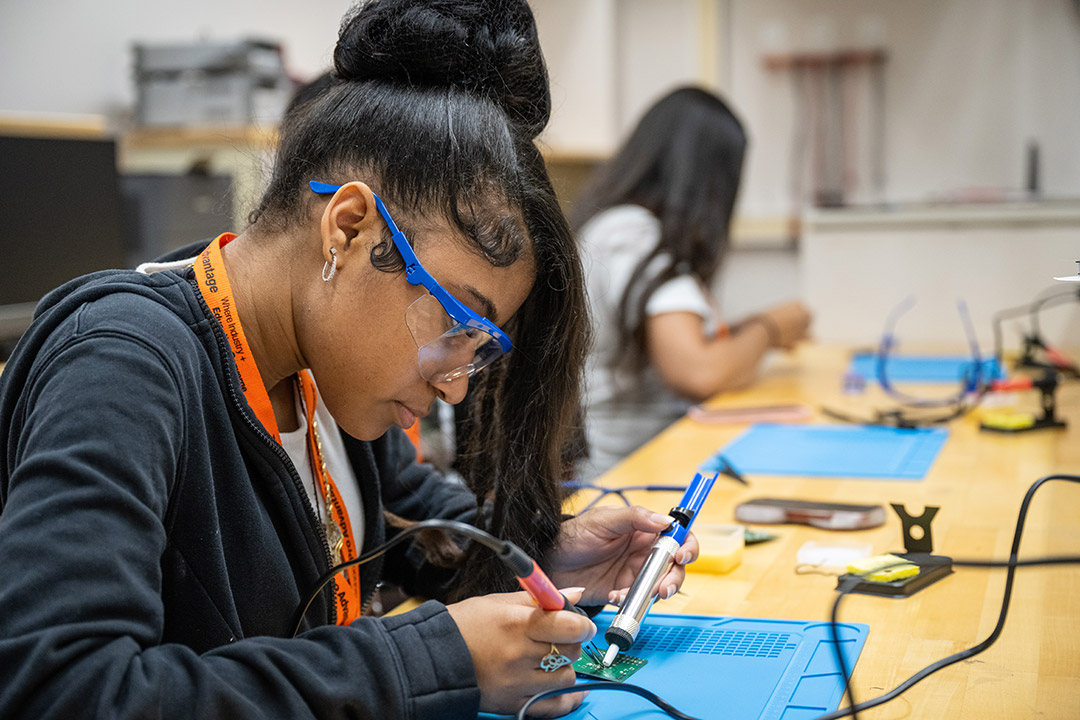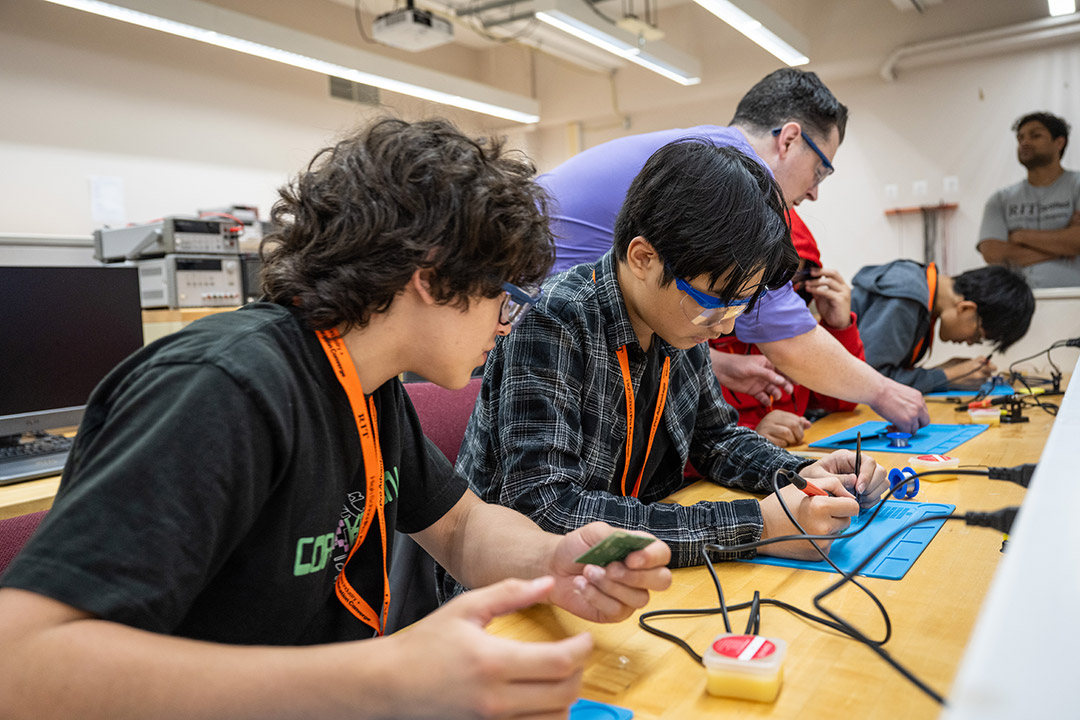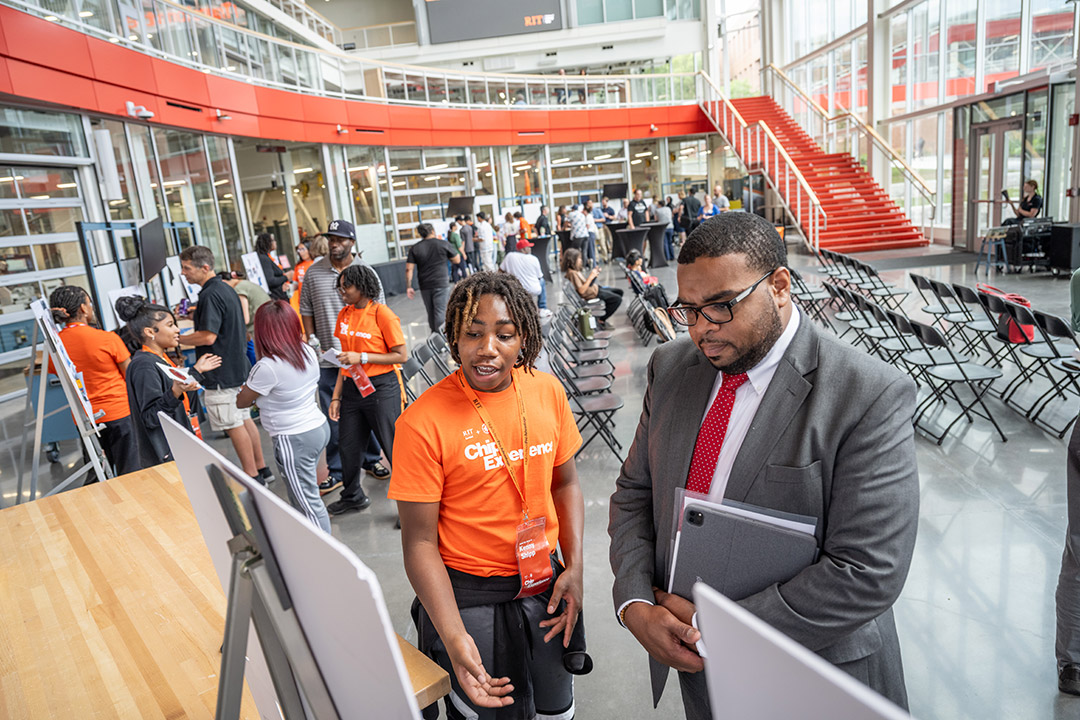High school students discover the big impact of tiny microchips during Chip Experience
Weeklong immersion, sponsored by RIT Certified, introduced Rochester City School District students to microchips and advanced manufacturing
Traci Westcott/RIT
Christy Bermudez, a rising junior at Rochester’s School Without Walls Commencement Academy, uses a desoldering pump to remove excess solder while making a circuit board during RIT Certified’s Chip Experience on July 9.
Christy Bermudez, a junior at School Without Walls Commencement Academy in the Rochester City School District, had previously thought about a career in nursing but, after participating in the Chip Experience immersion at RIT, she is now considering a career in engineering or technology.
Traci Westcott/RIT
Max Salinas-Miner, left, a rising junior from School of the Arts, and Chet Meas, a rising junior from Rochester Early College International High School, solder a circuit board during the Chip Experience immersion. In the background, Jason Hoople, a lecturer in the electrical and microelectronic engineering department, works with another student.
Bermudez was one of 14 high school students from the Rochester City School District who experienced the big impact of tiny microchips at the first Chip Experience immersion at RIT, July 8-12. The camp, sponsored by RIT Certified and led by RIT faculty and curriculum experts, featured hands-on opportunities for the ninth through 12th graders related to microchips and advanced manufacturing, including how to identify microchips on circuit boards, how the chips connect with other components, how to locate chips in deconstructed laptops donated by Sunnking Sustainable Solutions, and how to build their own circuit boards. The week culminated with a project showcase.
“I learned all about how a microchip looks and works,” said Bermudez. “One of the most fascinating parts was understanding how a light source like sunlight or even a flashlight can transfer patterns from paper onto a wafer. I even tested that theory and that was really cool.”
Chet Meas, a junior at Rochester’s Early College International High School, loved the hands-on experiences at Chip Experience, as well as meeting new friends throughout the week. While Meas is pretty set on his future as an engineer, exposure to other aspects of the field was a bonus.
“We learned about all of the components of a microchip and current flows. The way it was all explained helped it make sense. My favorite part of the week was definitely the soldering. I burned myself a little, but it was so much fun.”
In addition to creating their own microchip projects, the students stayed in campus residence halls, toured the Semiconductor Nanofabrication Lab clean room, and took a field trip to Plug Power, a company with local offices that is engaged in the development of hydrogen fuel cell systems that replace conventional batteries in equipment and vehicles powered by electricity.
The immersion provided the students with full tuition for the week, a $500 stipend per student, housing and meals, and transportation.
Traci Westcott/RIT
Rochester City School District Interim Superintendent Demario Strickland, right, talks with Kenny Shipp, a sophomore at School of the Arts, about his final project.
“The Chip Experience is a reflection of RIT Certified’s commitment to the regional and national semiconductor job economy and to our expanding relationship with the Rochester City School District,” said Dennis Di Lorenzo, executive director of RIT Certified. “This week was about removing barriers and providing support to Rochester youth, helping shape mindsets, and providing a vision for the future that is achievable for all.”
Demario Strickland, interim superintendent of the Rochester City School District, is thankful for the partnership with RIT and RIT Certified.
“We are deeply grateful to RIT for programs like the Chip Experience, through RIT Certified, which inspire our students to see themselves as innovators in the digital world,” said Strickland. “I believe this unique immersion in the microchip industry will ignite a passion in our students, guiding them to become leaders in the tech landscape rather than mere consumers.”
Last year, RIT was one of only six U.S. universities named as part of an international partnership announced by Micron Corp. and the National Science Foundation to improve competitiveness in computer chip design, development, and manufacturing. With an established microelectronic engineering degree program, one of the first in the country, RIT has more than 1,500 alumni working in the semiconductor field. The specialized program blends the theoretical knowledge and hands-on training required to design and build chips.
Additionally, upstate and central New York have been tapped to be a hub for advanced manufacturing in the industry. In October 2022, Micron announced it would invest up to $100 billion over the next 20 years to build a semiconductor fabrication center. It is expected to create thousands of new jobs in an effort to increase production of computer chip technology. The site was selected because of its proximity to multiple institutions of higher education, research and development laboratories, multiple related businesses to support the semiconductor supply chain, and a skilled workforce.













